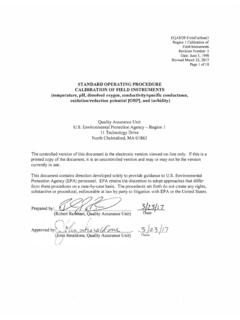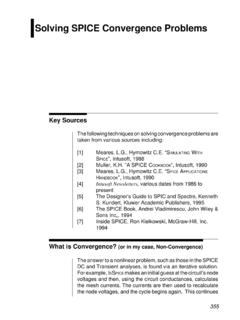Transcription of Theories of addiction: Causes and maintenance addiction of 4
1 Theories of addiction : Causes and maintenance of addiction 4. Overview: Theories of addiction In attempting to explain why people become dependent on drugs, a variety of different approaches have been taken. What follows is a summary of three different areas of explanation. The first concen- trates on the neurobiological effects of drugs, and explains drug dependence in biological terms. The second approach is psycho- logical, with explanations concentrating on behavioural models and individual differences. The final approach is sociocultural, with explanations concentrating on the cultural and environmental factors that make drug dependence more likely. As will become clear, there are a variety of approaches to the question of why people become dependent on drugs. These are not mutually exclusive. Neuroscientific Theories Neuroscientific Theories require an understanding of the effects of drugs on the brain, and Box outlines the actions of each of the major drug classes. Different drugs clearly have different primary actions on the brain, but two major pathways - the dopamine reward system and the endogenous opioid system - have been implicated as common to most drugs (Koob & LeMoal, 1997; Nutt, 1997).
2 33. Box Molecular and cellular effects of drug action Alcohol Alcohol has several primary targets of action, and identifying the mechanisms of action has proved to be a difficult task. Acute administration of alcohol leads to increases in inhibitory transmission at gamma-amino-butyric acid (GABA-A) channels, increased serotonin (5HT-3). function, dopamine release and transmission at opiate receptors, and a reduction of excitatory transmission at the NMDA subtype of the glutamate receptor (Altman et al., 1996; Markou, Kosten, & Koch, 1998). Nicotine Nicotine is an agonist at the nicotinic receptor that is, it activates the nicotinic receptor. Nicotinic receptor activation results in increased transmission of a number of neurotransmitters including acetylcholine, norepinephrine, dopamine, serotonin, glutamate, and endorphin (Benowitz, 1998). Cannabis The main active ingredient in cannabis is 9 tetrahydrocannabinol ( 9 -THC), which acts as an agonist at the cannabinoid receptor in the brain.
3 This action results in the prevention of the uptake of dopamine, serotonin, GABA, and norepinephrine (Comings et al., 1997). The cannabinoid (CB1) receptor is most common in the hippocampus, ganglia, and cerebellum (Comings et al., 1997). Opiates The brain's endogenous opioid system constitutes peptide including endorphins and enkephalins, which are stored in opiate neurons and released to mediate endogenous opiate actions (Altman et al., 1996; Nutt, 1997). Opiate drugs act as agonists at three major opiate receptor subtypes; (mu), (delta), and (kappa). The mu receptor appears to be the subtype important for the reinforcing effects of opiate drugs (Altman et al., 1996; Di Chiara & North, 1992). Mu receptors are largely located on cell bodies of dopamine neurons in the ventral tegmental area (VTA), the origin of the mesolimbic dopamine system; and on neurons in the basal forebrain, particularly the nucleus accumbens (Altman et al., 1996; Di Chiara & North, 1992). Delta opiate receptors may be important for the potentiation of the control of reinforcers over behaviour (Altman et al.)
4 , 1996). There is some evidence that kappa opiate receptors are involved in the aversive effects associated with withdrawal symptoms of opiates (Altman et al., 1996). Psychomotor Stimulants Cocaine Cocaine binds to dopamine, noradrenaline, and serotonin transporters (Altman et al., 1996), but it is thought that cocaine's blockage of dopamine re-uptake is the most important element mediating its reinforcing and psychomotor stimulant effects. This has been supported by recent evidence showing that dopamine D1-like receptors may play an important role in the euphoric and stimulating effects of cocaine. A D1 antagonist significantly attenuated the euphoric and stimulating effects of cocaine, and reduced the desire to take cocaine, among cocaine-dependent persons (Romach et al., 1999). Box Continued Amphetamine Amphetamine acts to increase monoamine release, as well as to increase release of dopamine, with secondary effects occurring in the inhibition of dopamine re-uptake and metabolism (Altman et al.
5 , 1996; Stahl, 1996). Similarly to cocaine, the enhanced release and inhibited re-uptake of dopamine is thought to be most important for amphetamine's reinforcing effects (Altman et al., 1996). Benzodiazepines Benzodiazepines act by binding with sites on the GABA-A/benzodiazepine receptor (Altman et al., 1996). This results in an increase in chloride conductance through chloride channels, thus enhancing inhibitory transmission. Increased dopamine transmission has been found in the VTA following acute benzodiazepine administration (Altman et al., 1996), but decreased dopamine levels occur in the nucleus accumbens. Dopamine reward system The mesolimbic-fronto cortical dopamine system (containing the mesolimbic and mesocortical dopamine systems) is regarded as a critical pathway in brain reward (Nutt, 1997; Wise, 1996). Dopamine has been implicated in the reinforcing effects of alcohol, with alcohol use resulting in the direct stimulation of dopamine and also an indirect increase in dopamine levels (Altman et al.
6 , 1996). It is also thought that the behavioural rewards of nicotine, and perhaps the basis of nicotine dependence, are also linked to the release of dopa- mine in the mesolimbic pathway (Benowitz, 1998; Markou et al., 1998). Following administration of nicotine, increased dopamine is released in rats, and lesions in the mesolimbic dopamine pathway lead to reduced self-administration of nicotine (Altman et al., 1996). Cannabis was long considered an atypical drug, in that it did not interact with the brain's reward system. However, research has revealed that the active component of cannabis, A'-tetrahydrocanna- binol (A9-THC), produces enhancement of brain-stimulation reward in rats, at doses within the range of human use (Gardner, 1992). Studies have also revealed cannabinoid receptors in areas associated with brain reward, and that A9-THC increases dopamine levels (Adams & Martin, 1996; Gardner, 1992). This suggests that cannabis does in fact interact with the dopaminergic system. Cocaine's effects have also been related to an increase in dopamine function (Bergman, Kamien, & Spealman, 1990; Caine & Koob, 1994; Spealman, 1990.
7 Spealman, Bargman, Madras, & Melia, 1991). Theories OF addiction 35. Endogenous opioid system There is evidence that the brain's endogenous opioid system may play an important role in drug use and misuse. Exogenous opiates such as heroin, morphine, and codeine act as opiate receptor agonists, and readily cause tolerance and dependence. Adaptation of opiate receptors occurs quite readily after chronic opiate use, as is seen in the need to use larger amounts to achieve pain relief or euphoria. Further, the opiate antagonist naloxone will quickly induce with- drawal symptoms if administered. Research is increasingly suggesting that the opioid system may be involved in the rewarding effects of other psychoactive substances. One form of therapy for alcohol dependence is the use of the opiate antagonist naltrexone, which has been shown to block the reinforcing properties of alcohol, suggesting that the endogenous opioid system may play an important role in the rewarding effects of alcohol.
8 Recent research suggests that long-term tobacco-smoking may cause changes in the responsivity of the endogenous opioid system, which leads to an increased likelihood of developing nicotine dependence (Krishnan-Sarin, Rosen, & O'Malley, 1999). Research has also found that doses of naloxone reverse the enhancement of brain reward caused by the active component of cannabis, A9-THC (Gardner, 1992). The dopaminergic and opioid systems have been characterized by some theorists as playing two different functions (Di Chiara & North, 1992). The dopaminergic pathway is associated with the incentive, preparatory aspects of reward, which are experienced as thrill, urgency, or craving. In contrast, the opioid system is associated with the satiation and consummatory aspects of reward, such as rest, blissfulness, and sedation (Di Chiara & North, 1992). Biological factors One area of research has concentrated on exploring biological characteristics that underlie drug dependence. These can be grouped into two kinds of explanations; one which examines individual differences in liability to drug dependence because of genetic characteristics, and one which accounts for drug dependence in terms of changes that occur in the brain due to chronic drug administration.
9 36 ADDICTIONS. Genetic factors One hypothesis concerning drug dependence is that people may inherit an increased likelihood (vulnerability) of developing depen- dence on substances. The question of whether or not such vulner- ability exists has been examined in the form of numerous family studies, adoption studies, and twin studies. Family studies of alcohol use disorders suggest that such disorders do cluster in families (Kendler, Davis, & Kessler, 1997; Merikangas, 1990; Merikangas et al., 1998). In a recent study, over one-third (36%). of the relatives of persons with an alcohol use disorder were also diagnosed with an alcohol use disorder (abuse or dependence), com- pared to 15% of the relatives of controls (Merikangas et al., 1998).This relationship was stronger in a study that examined the rate of alcohol dependence among siblings: among subjects identified with alcohol dependence, 50% of male siblings met criteria for alcohol depen- dence, compared to 20% of controls' male siblings; the respective rates for female siblings were 24% and 6% (Bierut et al.)
10 , 1998). Clearly, alcohol use disorder is likely to occur in more than one family member. Similar aggregation has been found for other drug use disorders (Bierut et al., 1998; Merikangas et al., 1998). Among persons whose predominant problematic drug was cannabis, 13% of relatives also had a cannabis use disorder, compared to of controls' relatives. The comparative rates for opiates were 10%vs. and, for cocaine, vs. (Merikangas et al., 1998). While these studies suggest that substance use disorders cluster within families, family studies do not allow us to separate the effects of genetic and environmental influences. The clustering may occur simply because the siblings share the same environment rather than any underlying genetic cause. The separate contribution of genes and environment can be teased apart in studies of adopted children and of monozygotic and dizygotic twins. Adoption studies examine rates of disorder among adoptees, given their biological and adoptive parents' disorder status.













